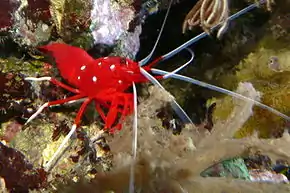Hippolytidae
Les Hippolytidae sont une famille de crustacés décapodes de la super-famille des Alpheoidea (crevettes).
Reproduction
De nombreuses études ont montré que la Protandrie (transformation de mâles en femelles) est un phénomène commun au sein de cette famille (mais chez certaines espèces uniquement chez les larves et postlarves) [1],[2],[3],[4],[5],[6] ainsi que dans l'infra-ordre où est rangée cette famille, par exemple chez les Pandalidae selon Jägersten (1936)[7] ; Mistakidis (1957)[8]; Allen (1959)[9] ; Butler (1964)[10] ; Berreur-Bonnenfant et Charniaux-Cotton en 1965[11] ; Hoffman (1972)[12]; Charnov (1981)[13], ou chez les Crangonidae selon Spitschakoff en 1912[14] ; Fréchette et al. (1970)[15] ou encore Boddeke et al. en 1991[16].
Liste des genres
Selon World Register of Marine Species (8 janvier 2021)[17] :
- genre Alope White, 1847b
- genre Caridion Goës, 1864
- genre Chorismus Spence Bate, 1888
- genre Cryptocheles G.O. Sars, 1870
- genre Eumanningia Crosnier, 2000
- genre Gelastocaris Kemp, 1914
- genre Gelastreutes Bruce, 1990
- genre Hippolyte Leach, 1814 (in Leach, 1813-1814)
- genre Latreutes Stimpson, 1860
- genre Leontocaris Stebbing, 1905
- genre Merhippolyte Spence Bate, 1888
- genre Nauticaris Spence Bate, 1888
- genre Paralatreutes Kemp, 1925
- genre Phycocaris Kemp, 1916
- genre Saron Thallwitz, 1891
- genre Thorella Bruce, 1982
- genre Tozeuma Stimpson, 1860
- genre Trachycaris Calman, 1906

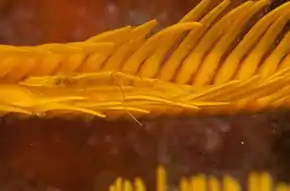
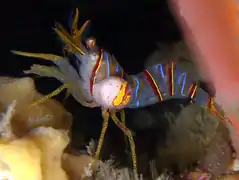 Lebbeus grandimanus
Lebbeus grandimanus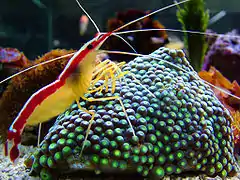
.png.webp) Lysmatella prima
Lysmatella prima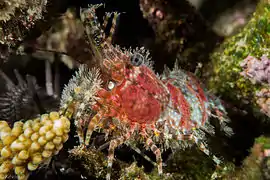
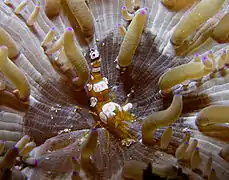
 Tozeuma armatum
Tozeuma armatum
Références taxinomiques
- (en) Référence World Register of Marine Species : taxon Hippolytidae Spence Bate, 1888 (+ liste genres + liste espèces)
- (en) Référence Paleobiology Database : Hippolytidae Bate 1888
- (fr+en) Référence ITIS : Hippolytidae Dana, 1852
- (en) Référence Animal Diversity Web : Hippolytidae
- (fr) Référence Catalogue of Life : Hippolytidae
- (en) Référence uBio : Hippolytidae Dana, 1852
- (en) Référence NCBI : Hippolytidae (taxons inclus)
Notes et références
- Dohrn PFR (1950) Studi sulla Lysmata seticaudata Risso (Hippolytidae) I Le condidicioni normali della sessualita in natura. Pubbl Stn Zool Napoli 22:257–272
- Noël P (1976) L’évolution des caractères sexuels chez Processa edulis Risso (Décapode, Natantia). Vie Milieu 25(1, sér. A):65–104
- Nakashima Y (1987) Reproductive strategies in partially protandrous shrimp, Athanas kominatoensis (Decapoda: Alpheidae): sex change as the best of a bad situation for subordinates. J Ethol 5:145–159
- Gherardi F, Calloni C (1993) Protandrous hermaphroditism in the tropical shrimp Athanas indicus (Decapoda: Caridea), a symbiont of sea urchins. J Crust Biol 13:675–689
- Fielder GC (1998) Functional, simultaneous hermaphroditism in female/phase of Lysmata amboinensis (Decapoda: Caridea: Hippolytidae). Pac Sci 52:161–169
- Simoes F, Yasir I, Jones DA (1998) Reproductive biology of Lysmata deberlius (Bruce, 1983) and L. amboinensis (De Man, 1888), (Crustacea: Caridea) tropical marine cleaner shrimps important in the sea water aquarium trade. Abstract. World Aquaculture Society. Las Vegas, p. 3
- Jägersten G (1936) Über die Geslechtsverhältnisse und das Wachustum bei Pandalus. Arkiv för zoologi 28:26Google Scholar
- Mistakidis MN (1957) The biology of Pandalus montagui Leach. Fish Inv London 21(2):52
- Allen JA (1959) On biology of Pandalus borealis Kroyer, with reference to a population off the Northumberland coast. J Mar Biol Assoc UK 38:189–220
- Butler TH (1964) Growth, reproduction and distribution of Pandalid shrimps in British Columbia. J Fish Res Board Can 21(6):1403–1452
- Berreur-Bonnenfant J, Charniaux-Cotton H (1965) Hermaphrodisme protérandrique et fonctionnemente de la zone germinative chez la crevette Pandalus borealis Kröyer. Bull Soc Zool Fr 90:240–259
- Hoffman DL (1972) The development of the ovotestes and copulatory organs in a population of protandric shrimp, Pandalus platyceros Brandt from Lopez Sound, Washington. Biol Bull 142:251–270
- Charnov EL (1981) Sex reversal in Pandalus borealis: effect of a shrimp fishery? Mar Biol Letters 2:53–57
- Spitschakoff TH (1912) Lysmata seticaudata Risso, als Beispiel eines echten Hermaphroditismus bei den Decapoden. Z Wiss Zool 100:109–209
- Fréchette JG, Corrivault GW, Couture R (1970) Hermaphroditisme protérandrique chez une crevette de la famille des crangonidés, Argis dentata Rathbun. Nat Can 97:805–822
- Boddeke R, Bosschieter JR, Goudswaard PC (1991) Sex change, mating, and sperm transfer in Crangon crangon (L.). In: Bauer RT, Martin JW (eds) Crustacean sexual biology. Columbia University Press, New York, p. 164–182
- World Register of Marine Species, consulté le 8 janvier 2021
- Portail de la carcinologie et des crustacés
- Portail de la biologie marine
